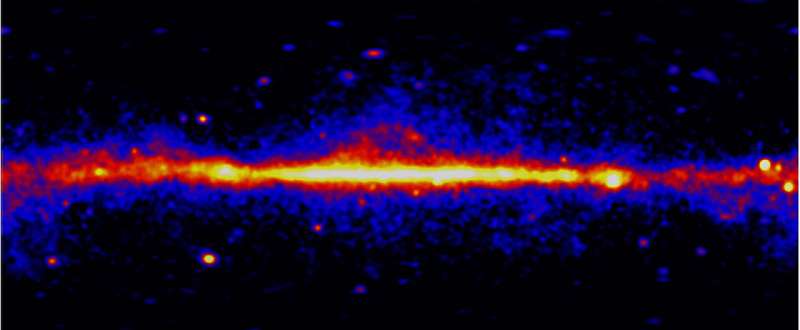Image source: NASA
Created from 14 years of data collected by NASA’s Fermi gamma-ray space telescope, a full-scale time-lapse movie brings the universe to life. Our sun occasionally shines brightly, calmly carving a path across the sky against a backdrop of high energy sources within and beyond the Milky Way.
“The Milky Way’s bright, steady gamma-ray glow is punctuated by intense, days-long bursts of near-lightspeed jets driven by supermassive black holes at the cores of distant galaxies,” said senior scientist Seth Digel. “flare.” These images were produced by work at the SLAC National Accelerator Laboratory in Menlo Park, California. “These violent eruptions could have appeared anywhere in the sky, occurred millions to billions of years ago, and their light was just reaching Fermi when we observed them.”
Gamma rays are the highest energy form of light. The film shows the intensity of gamma rays with energies exceeding 200 million electron volts detected by the Fermi Large Area Telescope (LAT) between August 2008 and August 2022. For comparison, visible light has energy between 2 and 3 electron volts. Brighter colors mark the location of more intense gamma ray sources.
“The first thing you see in the movie is the steady arc of light on the screen,” said Judy Racusin, associate scientist for the Fermi project. “That’s our sun, and its apparent motion reflects the Earth’s its annual orbital motion.” The film tour takes place at NASA’s Goddard Space Flight Center in Greenbelt, Maryland.
Most of the time, the LAT detects the Sun only faintly because accelerated particles called cosmic ray nuclei move at nearly the speed of light. Gamma rays are produced when they hit the sun’s gas or even light from the sun. Sometimes, though, the Sun suddenly brightens due to powerful bursts called solar flares, which can briefly make our star one of the brightest gamma ray sources in the sky.
The movie shows the sky in two different perspectives. The rectangular view shows the entire sky, with the Milky Way center in the middle. This highlights the Milky Way’s central plane, which glows in gamma rays produced by cosmic rays striking interstellar gas and starlight. It also contains many other sources, including neutron stars and supernova remnants. Above and below this central band, we can see the wider universe beyond the Milky Way, filled with bright, rapidly changing light sources.
Most of these are actually distant galaxies, which can be better observed from different angles centered on the Milky Way’s north and south poles. Each of these galaxies is called a blazar and has a central black hole with the mass of a million or more suns.
Somehow, black holes create extremely fast-moving jets of material, and with blazars we can almost look directly down at one of these jets, a view that enhances their brightness and variability.
“These changes tell us that something about these jets has changed,” Racusin said. “We regularly observe these sources and alert other telescopes in space and on the ground when something interesting happens. We have to catch these flares quickly before they disappear, and the more observational data we collect, the better we will be able to understand these events.”
Fermi plays a key role in a growing network of missions working together to capture these changes as they occur in the universe.
Many of these galaxies are very distant. For example, light from a blazar called 4C +21.35 has traveled for 4.6 billion years, meaning the flares we see today actually occurred when the Sun and solar system were beginning to form. Other bright blazars are more than twice as far away, and together they provide a stunning snapshot of black hole activity across cosmic time.
Many of the brief time events Fermi studied, such as gamma-ray bursts, the most powerful cosmic explosions, are not seen in time-lapse photography. This is the result of days of processing the data to sharpen the image.
The LAT concept was invented at SLAC, the instrument was assembled and tested at SLAC, SLAC is also responsible for the electronics and flight software, and SLAC continues to process new downlink data multiple times a day.
The Fermi Gamma-ray Space Telescope is an astrophysics and particle physics collaboration managed by Goddard. Fermi was developed in collaboration with the U.S. Department of Energy, with important contributions from academic institutions and partners in France, Germany, Italy, Japan, Sweden and the United States.
Provided by SLAC National Accelerator Laboratory
citation: Fermi mission creates 14-year time-lapse of gamma-ray sky (2023, December 20), Retrieved December 21, 2023, from https://phys.org/news/2023-12-fermi-gamma -ray-space-telescope-mission.html
This document is protected by copyright. No part may be reproduced without written permission except in the interests of fair dealing for private study or research purposes. Content is for reference only.
#Fermi #mission #creates #14year #timelapse #gammaray #sky
Image Source : phys.org
